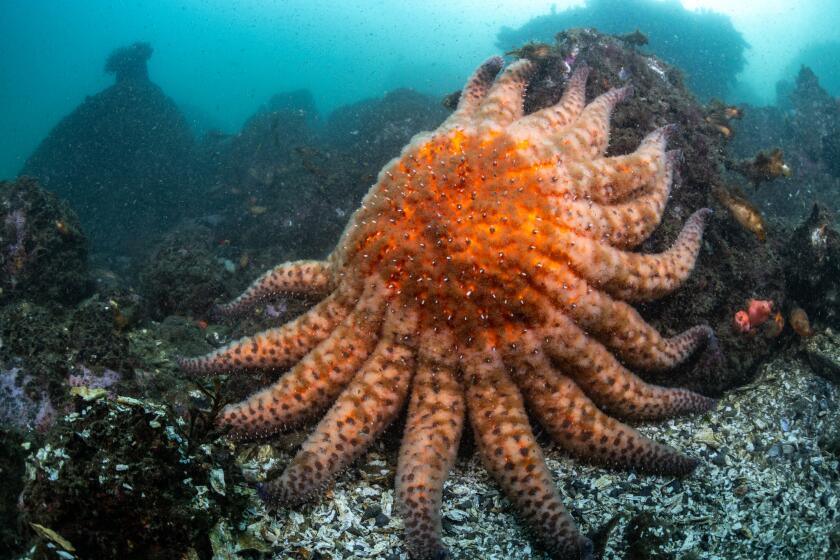Emus: The Craze That Didn’t Fly
- Share via
COLLEYVILLE, Texas — This is how insane the emu market was a few years back, just before the Vinson family got into the business of raising flightless birds:
An unhatched chick could fetch up to $4,000. Mature breeders were being insured at more than $50,000 a pair. Microchips had to be embedded under each animal’s skin to guard against rustlers. And boosters, flush in their diamonds and denim, seemed to be at every livestock show in the nation touting the lean red flesh of this ostrich-like creature as “the meat of the future.”
This is how insane the market is today, now that the novelty has worn off and America still favors a nicely marbled sirloin:
Thousands of emus are roaming the Texas countryside, set loose by ranchers unwilling to spend another dime on feed. Hundreds of others have been allowed to starve to death, their emaciated remains found in breeding pens that once drew eager investors. And the Vinsons? They became a symbol of the industry’s frustration this year after police caught them “euthanizing” their worthless flock--with an aluminum baseball bat.
It happened here in Colleyville, a rural suburb of Fort Worth, where two physician brothers, Stephen Vinson and Russell Vinson II, housed more than 100 emus in their father’s backyard. What looked like a lucrative venture had quickly become a money pit, costing the family thousands of dollars a year just to keep the gangly, 5-foot-tall, 100-pound critters alive. They tried to sell them, to give them away, to get a slaughterhouse to pick them up.
“Nobody wanted them,” said the Vinsons’ lawyer, Bill Magnussen. “So they tried to do away with them in the most humane way possible.”
That entailed heading out one fine June morning with an Easton 2 1/4-inch diameter “Big Barrel” slugger and whacking the birds over the head--an unwieldy feat that one Humane Society official compared to hitting a baseball at the end of a Slinky. Stephen, a 43-year-old emergency room doctor, allegedly did most of the swinging. Feathers flew. Blood splattered. The emus shook and stumbled and vomited. They were dragged to a trailer and dumped in a pile. By the time a horrified neighbor summoned police, 22 carcasses were ready for disposal.
“The emu’s a great bird,” said Don Feare, a Fort Worth attorney who lobbied, unsuccessfully, to get the Vinsons prosecuted for animal cruelty. “It’s the idiots who own them that are the problem.”
An Expensive Lesson for the Birds’ Breeders
These are ugly days for the emu industry, roused from a decade of champagne wishes and caviar dreams to face the morning-after. Instead of giving beef a run for its money, the bird has sucked dry most ranchers who have touched one, an expensive lesson in the fine line between a visionary and a fool.
In Texas, the emu capital of America with roughly a quarter of the nation’s emu breeders, membership in the state association has dropped from a peak of 2,700 to 320. The Ratite Marketplace--a national trade magazine catering to devotees of the emu, ostrich and rhea--has shrunk from 350 pages to fewer than 50. Like so many other animal fads, hope ultimately revealed itself as hype, leaving behind a mess of unwanted birds, squandered pensions, civil lawsuits, even criminal indictments.
“I was one of the greedy ones who got carried away with it,” conceded Ray Summers, a Lubbock rancher who both rode and fueled the wave of prosperity that enticed many a retiree to bank his life savings on Australia’s national bird.
He was so taken with the fast cash--prices tripled during his first three years selling emu chicks--that Summers penned a testimonial for the Ratite Marketplace in 1994, marveling at his almost foolproof formula for success. “I can’t personally figure out how to lose money in the ratite business,” he told readers in Volume 4, Issue 26. “If you have land, or friends or relatives that do, then get to be a part of this industry. You won’t be sorry. This is your opportunity now.”
The next year he bailed out, convinced that the market had become too speculative. A good number of friends and relatives stayed in and lost their shirts. “I really feel sorry for them,” said Summers, 62, who walked away with a tidy profit. He insists that his cheerleading was always sincere, if shortsighted. “Everything grew overnight, just as well as it fell overnight. We weren’t smart enough business people to plan for the future of the bird.”
Industry leaders are convinced that it still has a bright one, albeit more distant than they had first imagined. They view the shakedown of the last year or so as a natural, although indisputably painful, correction in the market--a process that is weeding out get-rich-quick schemers and finally allowing true believers to get down to work.
“If you haven’t approached it in a scientific or businesslike manner--and you’re not in it for the long haul--you’re going to go broke,” said Norbert “Stan” Stanislav, vice president and general manager of the Neiman Marcus store in Fort Worth.
Along with several partners, he owns one of the larger and more sophisticated emu ranches in Texas, an enterprise with deep enough pockets to ride out these bad times. Now entering the fifth year of a 10-year business plan, he acknowledges that he has yet to begin recouping his investment on a flock that recently numbered as high as 500. But that has not kept him from pushing the frontiers of emu production--experimenting with new feeds and breeding out inferior genes--all in the name of someday creating a bigger, better, more profitable bird.
“You can’t stand on the sidelines waiting for someone to carry you across the goal,” said Stanislav, who declined to reveal how much money he has in emus. “Although it is not an industry that you can say is there at this point in time, I have full confidence that it will be.”
Australian Aborigines Made the Meat a Staple
A staple of life for centuries among the aborigines of the Australian outback--just as the buffalo once sustained Native Americans--the emu was originally imported in the ‘30s and ‘40s as breeding stock for U.S. zoos. By the ‘80s, the descendants of those low-fat birds had become a fixture at exotic livestock auctions across the country, triggering an investment craze perfectly suited to a nation obsessed with diet and health.
“Call it the Ratite Rage,” began a story on the front page of this newspaper in 1992.
With its cattle-raising traditions, Texas took the early lead in building up the domestic emu population, which now numbers about 1 million, according to the Dallas-based American Emu Assn. Other states soon followed suit--including California, home to about 50,000 emus--but both the industry’s highs and the lows have been amplified here, largely due to the concentration of ranchers and birds.
Emu officials describe that initial frenzy as the “breeders market,” which is to say that demand for the birds was generated by capitalists rather than consumers. As long as more ranchers kept wanting in on the action, there was no limit to the prices--up to $60,000 a pair. And even at those inflated rates, the birds seemed like a bargain. If one pair of breeders could kick out 20 chicks, you could double your money in the first year.
“Everyone wanted to believe the stories that were being told,” said Tom Thomason, president of the Texas Emu Assn. “People got caught up in the hype.”
Once a consumer market had been developed--as in emu steaks on the barbie--everyone knew the prices would have to decline. You can’t very well be making hamburger out of a bird worth more than a Ferrari. Still, most thought the drop would be gradual, offset by the revenue of the slaughter. “Unfortunately,” Thomason said, “that transition came a lot quicker than any of us were prepared to deal with.”
Not only did it come quickly, but when it came, there was no consumer market to speak of. A handful of restaurants and specialty stores do offer the meat, but so far it has proved too expensive and exotic for mainstream American tastes. At Dunston’s, a Dallas steakhouse, a waitress scrunched her nose and groaned when asked about the $12.95 emu fillet on the menu. What’s more, the chef wrapped it in bacon, somewhat undermining the bird’s heart-healthy appeal.
To prevent waste, meat has been donated to prisons and homeless shelters. “We’re ranchers, not marketing or public relations experts,” said Thomason, who has yet to earn a penny on his $50,000 investment.
Gary Nassiff is a marketer, and he represents what many believe will be the industry’s salvation. He sells a line of products made with emu oil. An ancient aboriginal remedy, it is rendered from a fatty sack on the animal’s back, producing a soothing natural balm.
“I personally think it puts aloe vera to shame,” said Nassiff, whose Denton, Texas-based firm, Triad Promotions, makes 17 soaps and lotions, including Rhemu, an analgesic cream available in 2,800 Eckerd drug stores.
The oil is said to be good for sore joints and chafing skin. New York designer Donna Karan reportedly uses it in her cosmetics. Some NBA trainers rub it on the aching knees of their stars. The Texas Tech Health Sciences Center in Lubbock is studying its effects on burns and scars. “It even has a potential for helping hair grow back,” said Nassiff, who quickly added: “This is not a white-shoed salesman, snake-oil story. It really is an amazing product.”
One problem: Nassiff gets most of his emu oil from Australia. “We need good oil, guaranteed,” he said. “American farmers have been slow getting to that point.”
Whole Business Called Just a Pyramid Scheme
For skeptics, ranging from animal-rights activists to belly-up ranchers, the whole emu thing is starting to smell pretty rotten. “It was a typical pyramid scheme,” said Linda Yarbrough, who works with the Texas Establishment for Animal Rights.
As she and others like to point out, the only way anyone made money in the business was by passing the birds from one rancher to another. Indeed, it was not in the industry’s short-term interest to even think about moving to a consumer market, not as long as the goose could still lay the golden egg for new investors.
“There was no end user, no end product, but the people selling these birds were not telling that to the idiots buying them,” said Feare, the Fort Worth attorney, who operates his own wild fowl refuge. “They sold an idea, just like those guys on TV at 3 a.m. who do infomercials on a yacht next to a girl in a bikini and say, ‘Send me money and I’ll show you how I made millions.’ ”
As for the new faith in emu oil? “Hallelujah,” deadpanned Dennis White, regional director of the Humane Society of the United States.
Not surprisingly, those still trying to stay afloat in the emu business get a little prickly about this kind of talk. In October, a group of Texas ranchers sued the American Honda Motor Co. over a 1996-97 TV ad, which featured a young man named Joe who drives his Honda from one dubious job interview to another. At one stop, he meets a crusty character who tells him: “Emu, Joe, it’s the pork of the future.”
The lawsuit, pending in U.S. district court in Amarillo, contends that the ad disparaged those in the industry and “placed emu in a false light by depicting it as a scam.”
As it was, the emu industry did not need a whole lot of help in that department, having inflicted a fair amount of damage on its own.
Investigations by the Texas Securities Board have led to the indictments of at least nine people on charges of running fraudulent emu-breeding operations.
In the north-central Texas town of Corsicana, Lela Barker Hill pleaded guilty this year to one misdemeanor count of animal cruelty for the starvation deaths of 56 emus, a scene of deprivation that “would make you sick to your stomach,” said Municipal Court Judge April Sikes. If he ever sets foot back in the eastern Texas community of Lufkin, former emu breeder Clinton T. Hall could face similar charges for abandoning his 400 birds, more than 300 of which starved to death, according to the city’s animal control director, Cathy Clark.
“He was trying to get out of the business with the least expense possible,” said Clark, who had to build a special pen to house the 69 survivors. After four months, there were still no takers, so she sent the emus to a slaughterhouse. Their meat was fed to the poor.
In Colleyville, police halted the Vinson brothers from bludgeoning their remaining emus, 87 of which were seized by the Humane Society and shipped to a Northern California refuge. The Tarrant County district attorney’s office, however, declined to prosecute the men. State law prohibits Texans from torturing their animals, but not from killing them.
How many more emus are unaccounted for, cut free by ranchers who refuse to pay the $5 to $10 a month that each one costs in feed? Nobody knows for sure, but there have been hundreds of sightings all over the state, especially on rural back roads, where the birds have caused many a motorist to slam on the brakes. So far, no serious accidents have been reported.
“I’m afraid it’s going to happen sooner or later,” said Luke Griffin, sheriff of Baylor County in remote northern Texas. He gets complaints about stray emus almost every week. “If you try to mess with one, somebody always ends up getting kicked or scratched. Usually, we just hit the lights and siren, to try to scare them off the road.”
A few months ago, however, his officers encountered a crazy bird that no amount of prodding seemed to spook. “Finally,” Griffin said, “we just had to shoot it.”
He Never Became a ‘Gentleman Farmer’
Dennis Shea didn’t want to make the news for doing something ugly to his birds. Instead, he put a classified ad in the Fort Worth Star-Telegram: “Free emus,” it said. He gave away 18. “It’s been a pretty tough row to hoe,” he sighed.
Shea was standing in the backyard of his suburban farmhouse, once the Rolling Thunder Ranch. He bought the spread in 1993, hoping to leave behind his fast-track executive job and start life over as “a gentleman farmer.” He sank $27,500 that he didn’t have into a pair of breeders. Then came the fencing, the feeders, the incubators, the hatchers, the $1,200 state-of-the-art microchip reader to protect his birds against theft.
“This was my showcase,” said Shea, 49, running a hand through his thinning gray hair. Now the grass is choked with weeds. The fences are sagging. The high-tech equipment sits in a decrepit shed. He’s gone back to work, selling used cars. “I had a dream crushed,” he said.
His wife, Eunice, tells him he got duped.
Dennis finds it difficult to argue otherwise.
But hope dies hard.
“Come here, Buddy. Come here, Beauty,” he cooed.
His two top-dollar breeders, the ones that started it all, loped over to the edge of their pen.
This pair, he’s held onto. Just in case.
Times researcher Lianne Hart contributed to this story.
More to Read
Sign up for Essential California
The most important California stories and recommendations in your inbox every morning.
You may occasionally receive promotional content from the Los Angeles Times.










